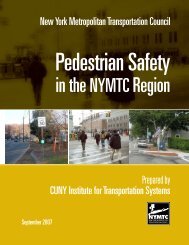Coordinated Public Transit-Human Services <strong>Transportation</strong> Plan for NYMTC Region • FinalN E W Y O R K M E T R O P O L I T A N T R A N S P O R T A T I O N C O U N C I L• L O N G I S L A N DFigure 3-1Long Island SubregionAreaLong Island’s total area is approximately 2,800 square miles; but over 1,600 of that is water.Suffolk County is much larger than Nassau County, covering 912 square miles of land area, whilethe total land area of Nassau County is 287 square miles. Brookhaven, in Suffolk County, andHempstead, in Nassau County, are the largest towns on Long Island, covering 259 square milesand 120 square miles, respectively. Long Beach, in Nassau County, is the smallest municipalityin either of the counties, covering only two square miles of land area. Figure 3-2 below lists thetotal area and land area for the Long Island subregion.Figure 3-2Long Island Subregion Area by CountyTotal Area (Sq. Miles) Land Area (Sq. Miles)Nassau County 453 287Suffolk County 2,373 912Long Island 2,826 1,199Source: US Census (2000); figures are rounded estimatesPopulation and Population GrowthPopulation counts for Long Island date back to 1790 for Suffolk County and 1900 for NassauCounty. Combined total population for the two counties did not reach one million until after 1950.Figure 3-3 below provides detail on the population changes in both counties, and for Long Island.Page 3-2
Coordinated Public Transit-Human Services <strong>Transportation</strong> Plan for NYMTC Region • FinalN E W Y O R K M E T R O P O L I T A N T R A N S P O R T A T I O N C O U N C I L• L O N G I S L A N DFigure 3-3Long Island Population History1950 Pop. 1960 Pop. 1970 Pop. 1980 Pop. 1990 Pop.2000Pop.Nassau County 672,765 1,300,171 1,428,838 1,321,582 1,287,348 1,334,544Suffolk County 276,129 666,784 1,127,030 1,284,231 1,321,864 1,419,369Long Island 948,894 1,966,955 2,555,868 2,605,813 2,609,212 2,753,913Source: US Census; US Department of CommerceBetween 1950 and 1960, the population in Nassau County doubled and in Suffolk County, thepopulation almost tripled. Between 1960 and 1970, the population grew again, though at aslightly slower rate. After 1970, the total population in Nassau County fell slightly, from 1,428,838in 1970 to 1,321,582 in 1980, to 1,287,348 in 1990. In Suffolk County, the population increasedfrom 1,127,030 in 1970 to 1,321,864 in 1990.As of the 2000 Census, total population for the Long Island subregion was approximately 2.7million. This figure is almost evenly divided among Nassau and Suffolk counties. In NassauCounty, there were about 1.3 million people and in Suffolk County, about 1.4 million. The Townof Hempstead in Nassau County was the most populated of all the municipalities, with 755,924people. Brookhaven, in Suffolk County, was the second most populated, with almost 450,000people. Shelter Island was the least populated by far of any town or city on Long Island, with only2,228 residents.According to Census Bureau estimates, the population on Long Island grew by only 1.5 percentfrom 2000 to 2006, less than both the state average (1.7 percent) and the national average (7.2percent). Population in Nassau County decreased, but by less than one percent. The towns ofHempstead and North Hempstead in Nassau County both experienced a decrease in population.In Hempstead, the population shrank by over six percent. In Suffolk County, the population grew,but only by 3.5 percent, very similar to the growth experienced in <strong>New</strong> <strong>York</strong> City (3.3 percent).Smithtown experienced the lowest rate of growth, less than one percent, and Huntingtonexperienced the highest growth rate, almost seven percent. Figure 3-4 below shows the changein population for Long Island.Figure 3-4Long Island Subregion Population and PopulationChange by County2000 Population 2006 Population Change % ChangeNassau County 1,334,544 1,325,662 (8,882) (0.7%)Suffolk County 1,419,369 1,469,715 50,346 3.5%Long Island 2,753,913 2,795,377 41,464 1.5%Source: US Census (2000); figures are rounded estimatesThere is an important caveat to these 2006 estimates. For the following year’s estimates, NassauCounty disputed the original Census Bureau’s 2007 population findings. The county believes thatthe Census undercounted population by 50,000. Population estimates for Long Island for 2007,developed by the Nassau County Planning Department, were recently accepted by the CensusPage 3-3
















